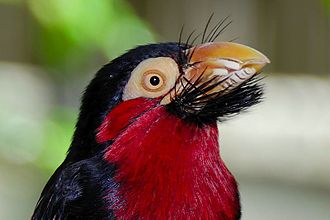Nasal bristle

In birds, nasal bristles are thin feathers that grow from the front region of the forehead towards the upper beak and partially cover or protrude from it. They are a modified form of beak bristles and have developed independently of one another in different groups of birds. Nasal bristle plumage is therefore sometimes structured very differently. The individual springs, however, have a similar structure: They only consist of an elongated spring shaft and have no flags. There are only a few feather branches at the base. As a typical and original feature Nasalborsten apply especially in the family of corvids (Corvidae), whose members, with few exceptions over-fitting, dense cushions feature of Nasalborsten that cover their nostrils. In the form of only slightly modified tactile bristles, nasal bristles are also found in many woodpecker birds ( Piciformes), such as the bearded birds (Capitonidae). Here they usually do not cover the beak, but grow diagonally upwards from the forehead region and surround the upper beak with a wreath of long, free-standing bristles that can be put on and together with the beak bristles sometimes looks like a beard . In addition, they also occur in many other species and families in different forms. The function of nasal bristles differs depending on the shape. While they serve as a cushion over the nostrils to protect against injuries and dirt, the long, free-standing bristles of other groups act as tactile organs, comparable to the whiskers of some mammals . In the case of insectivorous species, nasal bristles also often function as a trap, making it difficult for prey to escape.
Sources and References
literature
- Trevor Carnaby: Beat Around the Bush: Birds. Jacana Media, Johannesburg 2008. ISBN 978-1-77009-241-9 .
- Steve Madge , John Marzluff: Family Corvidae (Crows and Allies). In: Joseph del Hoyo, Andrew Elliot, David Christie (Eds.): Handbook of the Birds of the World. Volume 14: Bush-shrikes to Old World Sparrows. Lynx Edicions, Barcelona 2009. ISBN 978-84-96553-50-7 , pp. 494-640.
- Lester Short, Jennifer FM Horne: Toucans, Barbets and Honeyguides: Ramphastidae, Capitonidae, and Indicatoridae. Oxford University Press, New York 2001. ISBN 0-19-854666-1 .
